





Particularly prominent in my childhood memories are flower-picking excursions on the first warm days of spring. Mother delighted my sisters and me when she suggested a trip into the woods to pick honeysuckle. We didn?t know that they were really native azaleas, and we certainly had never heard such words as Rhododendron canescens. Nevertheless, these intoxicatingly fragrant flowers evoke fond memories every spring when they bloom in woods and landscapes throughout the South.
In early spring, Amiable Spouse and I take a boat ride up the Mitchell River in Walton County, Florida. We call ourselves fishing, so we drift along with baited hooks dangling from our fishing rods. Occasionally our corks bob a bit, but we both acknowledge that catching fish is not our primary goal.From the boat we see masses of native azaleas blooming along the banks of the river. Butterflies flit from flower to flower, and hummingbirds zoom about on iridescent wings, sipping the nectar. The first grunts of the alligators can be heard from deep within the swamp, and turtles abandon their sunny log perches and plop into the water as the boat approaches. High in the cypress snags osprey fledglings await their dinner. Red swamp maple is blooming, and the new golds and greens of emerging foliage reflect in the water. The fragrance of native azaleas infuses the air, the sun warms our backs, and as we glide down the river we are regaled with the magic of spring.
Florida Flame Azalea
Among the beautiful sights that we see along the river in early spring are the Florida flame azaleas or Florida azaleas (Rhododendron austrinum). Bright golden clusters of tubular flowers about 1.5 inches wide and 2 inches long radiate out in a circle from the tips of the shrubs' stems. The tube of each blossom is sometimes blushed with peach, red, or pink, and long stamens and pistils sweep out and curve gracefully upward. Sticky glanular hairs cover the flower tube.
The Florida flame azalea grows about 6 to 8 feet tall and two feet wide, though in the river bottoms where it competes for light and space, it may be rangier. It is hardy in USDA Zones 7 to 9 and is native to the Florida panhandle and a few counties in southern Georgia, Alabama, and Mississippi. It is drought tolerant once established, and is a popular landscape plant within its hardiness zone.
Pinxter Azalea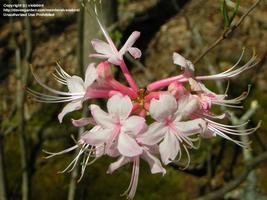
Also along the river can be seen R. canescens. Sometimes called the Florida pinxter or the Piedmont azalea, this one, too, is very fragrant. Flowers are usually pink, but may also be white. Stamens twice as long as the tube stick out from the flowers. This is the azalea that we picked as children along the creek banks in rural Mississippi. Although Mother called them honeysuckle, I know now that they are not related to the honeysuckles but were so named because of their honeysuckle-like fragrance.
Pinxter azaleas grow 8 to 12 feet tall and spread to form colonies. In Florida they are commercially exploited, and in Tennessee they are endangered. Hardy in Zones 6b to 10a, they are the most well-known native azalea of the southeastern states.
Swamp Azalea
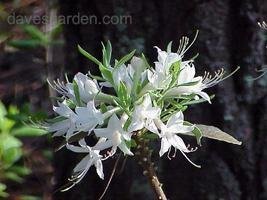 Rhododendron viscosum is another azalea native to Florida as well as all the states that border the Gulf and Atlantic coasts from Texas to Maine. Called the clammy azalea or the swamp azalea, it is endangered in Maine, threatened in New Hampshire, and exploitably vulnerable in New York. This deciduous azalea blooms in summer with small white, funnel-shaped, clove-scented flowers. As its name suggests, this clump-forming azalea is suited to poorly-drained soils and wetland areas. Foliage is lustrous and green during the summer, but turns flame red in fall.
Rhododendron viscosum is another azalea native to Florida as well as all the states that border the Gulf and Atlantic coasts from Texas to Maine. Called the clammy azalea or the swamp azalea, it is endangered in Maine, threatened in New Hampshire, and exploitably vulnerable in New York. This deciduous azalea blooms in summer with small white, funnel-shaped, clove-scented flowers. As its name suggests, this clump-forming azalea is suited to poorly-drained soils and wetland areas. Foliage is lustrous and green during the summer, but turns flame red in fall.
Chapman's Azalea
One of the rarest of all the native azaleas is endemic to northern Florida. Known as Chapman's rhododendron (Rhododendron chapmanii), only three naturally-occurring populations are known. Growing 3-6 feet tall, this evergreen azalea has open, stiffly ascending branches and bears clusters of pink flowers in spring. No wonder it is on both the federal and Florida endangered species lists.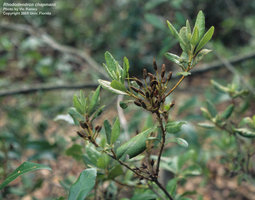
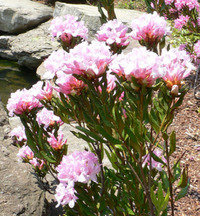
Chapman's azakea after blooming
Chapman's azalea in bloomOther Native Azaleas
Rhododendron calendulaceum (flame azalea), is also native north Florida according to the University of Florida. 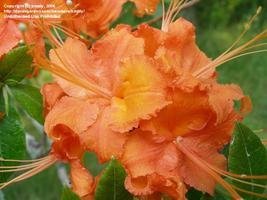 However, the USDA website indicates that its range stops just short of Florida. While not necessarily native to Florida, several other native azaleas may be suited to gardens in parts of Florida. These azaleas are native to states just north of Florida, and are grown throughout the southern and eastern states. These include the Alabama azalea (R. alabamense, Zones 6a to 9b): the dwarf or coastal azalea (R. atlanticum, Zones 5 to 9a); the Cumberland azalea (R. cumberlandense, Zones 5a to 8b); the pruneleaf azalea (R. prunifolium, Zones 5 to 9); the sweet or smooth azalea (R. arborescens, Zones 5-9A); pinxterbloom or pink azalea (R. periclymenoides, Zones 4 to 9); and the Oconee or piedmont azalea (R. flammeum, Zones 6a to 9b). Only R. vaseyi and R. canadense prefer a location in more northerly regions of the United States.
However, the USDA website indicates that its range stops just short of Florida. While not necessarily native to Florida, several other native azaleas may be suited to gardens in parts of Florida. These azaleas are native to states just north of Florida, and are grown throughout the southern and eastern states. These include the Alabama azalea (R. alabamense, Zones 6a to 9b): the dwarf or coastal azalea (R. atlanticum, Zones 5 to 9a); the Cumberland azalea (R. cumberlandense, Zones 5a to 8b); the pruneleaf azalea (R. prunifolium, Zones 5 to 9); the sweet or smooth azalea (R. arborescens, Zones 5-9A); pinxterbloom or pink azalea (R. periclymenoides, Zones 4 to 9); and the Oconee or piedmont azalea (R. flammeum, Zones 6a to 9b). Only R. vaseyi and R. canadense prefer a location in more northerly regions of the United States.
For identification purposes, the fifteen species of native azaleas are divided into three groups; the white group, the pink group, and the orange group. Species in the white group include Rhododendron alabamense, R. arborescens, R. atlanticum, R. viscosum, and a recently discovered species that occurs only in South Carolina, called R. eastmanii. The white group also includes, R. occidentale, which occurs on the west coast. Included in the pink group are R. canadense, R. canescens, R. periclyminoides, R. prinophyllum, and R. vaseyi. The orange group includes R. austrinum, R. calendulaceum, R. cumberlandense, R. flammeum, and R. prunifolium.
Culture
Native azaleas should never be taken from native stands, for many of them are endangered. Reputable nurseries offer plants that are not collected from native stands. In the landscape, native azaleas prefer rich, moist, acidic soil in light shade. A thick mulch will help to preserve soil moisture and protect the shallow roots. Pruning is seldom necessary, and any that is needed should be done immediately after flowering since plants bloom on the previous season's growth. Plants can be propagated by seeds or by softwood cuttings.
Enhancing my article, and used with appreciation are R. viscosum by lilwren, R. canescens by violabird,
R. calendulaceum by irmaly, and R. chapmanii from Wikipedia and the University of Florida (with permission).
Blooms for the Florida Fall and Winter Garden: Not Just Orange, Yellow and Red
10 Top Native Plants for the Rocky Mountain Region
8 Essential Native Shade Trees for the U.S. Southeast
10 Spring Wildflowers for the Central Plains
10 Essential Wildflowers for the U.S. Central Plains
Copyright © www.100flowers.win Botanic Garden All Rights Reserved